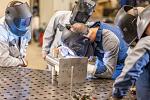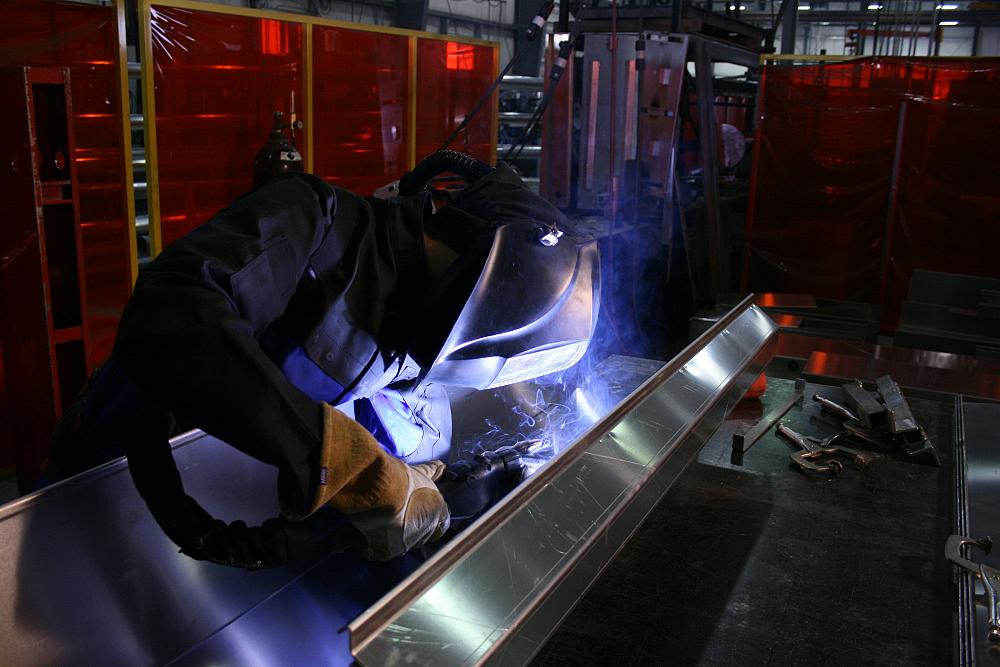- FMA
- The Fabricator
- FABTECH
- Canadian Metalworking
Flat welding and horizontal welding: All about weld position
Proper positioning parts when welding is crucial for quality and efficiency.
- By Nestor Gula
- Updated January 16, 2023
- August 19, 2013
- Article
- Welding
Too often we see the image of a welder on television and in the movies. Standing splay legged, holding the welding torch above his head in a dramatic, even heroic, image.
The only thing that is real about that image is that the weld -- more often than naught, will not be a proper weld. Proper welds are made with the joint to be welded lying flat and the weld torch, or stick, moving horizontally. All other welds are called "out-of-position" welds and are trickier to do, and require an operator with considerable skill to complete them properly.
“The welding position affects everything about the weld: penetration, speed, tie-in at the toes of the weld, spatter, torch angle, work angle, volts, amps and wire feed speed," said Kevin Summers, commercial business manager for Miller Welding Automation.
“Welding in a flat or horizontal position, the puddle can be very fluid and still remain in the joint. When those same conditions are used in the vertical position, the weld will literally run out of the joint. As the operator turns down the voltage, current, wire feed speed and travel speed to create a colder, less fluid puddle, the penetration goes down.”
You Won't Be Out-of-Position with Flat Welding
For a welder, the horizontal position of welding is the easiest, most ergonomic and safest.
“It is a lot easier if we can position the weld in front of the welder. It will be much easier for them to get access to the joint. They’ll be able to see the joint and see what they are doing,” said Mike Morgan, General Manager, Automation for Lincoln Electric.
"A horizontal weld is the easiest to weld," adds Jeff Chittim, application specialist for ESAB Welding & Cutting Products. “It is what people always try to weld in. The biggest thing that is against out-of-position welding is gravity. When you are welding you have molten material and so it is liquid. When you are out-of-position it wants to run out of the weld and it just wants to flow wherever gravity takes it. When you are welding vertically up or overhead, there is nothing there to support the weld metal so that is when welding gets a little bit more tricky.”
Welding out-of-position is a slower procedure and uses more resources to accomplish the same quality of weld. This flat horizontal position allows for the maximum travel speed. “You can have a very hot/fluid puddle that stays in the joint and gain faster travel speeds.
"Welding out-of-position is slow,” said Summers. “You have to dial everything back to keep the puddle from dripping. You also have to manipulate the puddle more when welding out of position, which takes more time and ultimately cost you travel speeds. You can do upside down welding, it is just that you have to slow down and be very careful because the weld material has a tendency to work with gravity and drop on you,” said Morgan.
“You have to place very small passes down, stringer passes so you put in very low deposition it is a very difficult weld to make, even in automation.”
[gallery type="slideshow" ids="96405,98828,98825,98827"]
Not all welders have the skill to perform proper this type of welding. “Out-of-position welding takes a little bit more time and it also takes a higher skill level to do,” said Chittim.
“That’s one of the reasons people would rather weld in the flat horizontal position especially doing structural work or pipelines. Usually if you are doing a vertical up you might need to increase your gas flow a little bit just to ensure that you have proper coverage. Typically it is not a real big issue. If you are overhead the gases are actually being trapped in the joint above you,” said Chittim. “But then again most of out of position welding is being done on structural or bridge is outside so then you will be having increased flow rates already.”
Welding overhead is the worst case scenario for most welders. If you can’t do anything and you have to weld overhead using a flux-cored wire is a good option, suggests Morgan.
“One thing people will look at is using a flux-cored wire because it is certainly a lot easier to use a flux-cored wire overhead than it is a solid wire because it is able to help the weldment to freeze. What precautions you do use is to use smaller beads so you will have to do a multipass weld. It will take a lot more time and it will not look as pretty.” Pipeline welding uses stick or flux-cored wire because they can’t escape from welding upside down, he adds.
“If you use a solid wire you will have to weave a lot more and weld to the sides of the joint to try and dissipate the heat a lot more than you would with the flux-cored,” said Morgan. If you must use a solid wire, “you tend to get a better freezing action the more argon you put in. The more CO2 you put in the more fluid it becomes. So it is easier to weld out of position with a mixed gas.”
Positioning in Horizontal Welding
When welding small and lightweight objects, there really is no reason why a welder cannot move the object to suit the preferred flat and horizontal welding position.
Where things get interesting is when automated robotic welding comes into play. For this there are positioners that can be programmed, like the robotic welders to rotate and move the object being welded to the right position.
“Positioning equipment on robotic work cells help with the return on investment (ROI),” says Summers.
“By repositioning the weld or using coordinated motion with a positioner and the robot, you can maximize your welding speed, which helps increase productivity and profit.”
Positioners come in a variety of sizes from units that can handle about 50 kilos to ones that manipulate more than ten tons. From simple table like machines and some that resemble forklifts, the positioners are designed to always present the weld in the flat and horizontal plane to make welding easier for both automation and hand.
Paul Raczynski, Director of Operations at Rapol Inc., a Woodstock, Ontario based manufacturer of positioners, remembers visiting a trailer factory where a whole trailer was suspended by chains from cranes.
It was lifted up, rotated a bit, set down, a joint welded (in a horizontal and flat position), and then the procedure was repeated. This situation could be easily made efficient using a headstock/tailstock system that can be described as something similar to a rotisserie system.
Morgan said, “if you are going to spend the money on a robot, on a track to go up and down the length of a trailer, you might as well put in a headstock/tailstock system as well and integrate the whole thing and always present the weld in the best position.”
About the Author
subscribe now


Keep up to date with the latest news, events, and technology for all things metal from our pair of monthly magazines written specifically for Canadian manufacturers!
Start Your Free Subscription- Trending Articles
Class is in session for college connections

BlueForge Alliance partners with Nuts, Bolts & Thingamajigs to develop Submarine Manufacturing Camps

Engine-driven welding machines include integrated air compressors

Orbital tube welding webinar to be held April 23

Portable system becomes hot tech in heat treatment

- Industry Events
ZEISS Quality Innovation Days 2024
- April 15 - 19, 2024
Tube 2024
- April 15 - 19, 2024
- Düsseldorf, Germany
CTMA Economic Uncertainty: Helping You Navigate Windsor Seminar
- April 30, 2024
- Windsor, ON Canada
MME Winnipeg
- April 30, 2024
- Winnipeg, ON Canada
CTMA Economic Uncertainty: Helping You Navigate Kitchener Seminar
- May 2, 2024
- Kitchener, ON Canada
















